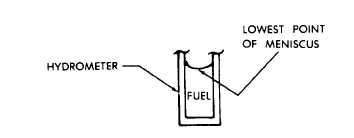TM 55-1500-342-23
Section II. WEIGHING PRACTICES AND PROCEDURES
3-4. Preparation of Aircraft for Weighing. The
following general procedures are outlined as an aid to
preparing the aircraft for weighing. Preliminary weighing
instructions for a specific type of aircraft are contained
in the applicable maintenance manual for that aircraft.
a. Clean aircraft inside and out.
b. Remove expendable load items such as bombs,
ammunition, cargo, and equipment not having a fixed
position. These items are not included as DD Form
365-1 items and should not be in aircraft when weighed.
c. Check aircraft equipment against DD Form 365-
1 and correct form as necessary to itemize accurately all
items of fixed operating equipment that will be included
in basic weight to be determined by weighing. DD Form
365-1 serves as a check list for this operation and is
necessary to accomplish the inventory. When such a
list does not accompany the aircraft, it is the duty of the
weight and balance supervisor to prepare one before
weighing. The date on which inventory is accomplished
will be entered at the top of the check column of DD
Form 365-1; this should correspond with that date
entered on DD Form 365-2 and final entry posted on DD
Form 365-3. Upon completing inventory, make proper
entries in columns I and II of DD Form 365-2.
d. Fill or drain fuel tanks in accordance with Chart
E instructions. All other engines and transmissions,
reservoirs, and/or tanks should be full unless otherwise
specified in aircraft weighing instructions. Weights of
fluids that are included on DD Form 365-1 shall not be
entered on DD Form 365-2. In certain instances it may
not be feasible to drain fuel tanks; if this is so, fill tanks
to capacity.
Weights of full tanks may be found by use of Chart E
data. The density (pounds per gallon) of fuel, however,
varies with temperature and it is often necessary to
determine fuel density by using a hydrometer. (See
figure 3-2.)
NOTE
Float hydrometer in a sample of
fuel and record the weight per
gallon; read this value at the
lowest point of the meniscus.
Fuel densities listed in Chart E are usually based on a
standard atmospheric temperature of 59°F (15°C).
When large deviations from this standard temperature
occur, fuel samples must be drawn from a tank and
density determined by use of a hydrometer. The total
weight of fuel aboard may then be calculated by
multiplying the total number of gallons aboard by fuel
density. The weight of fuel must be entered under
column I of DD Form 365-2, as it is considered as item
weighed but not part of basic weight.
NOTE
It is not the intention herein to
give
detailed
instructions
on
methods used to level aircraft,
since methods vary with the type
of aircraft and the reaction points
to be used. Normally aircraft are
weighed in a level position, which
is defined as that aircraft attitude
in which the longitudinal and
lateral axes are essentially to the
hangar floor. Leveling devices
such as leveling lugs and jig-
located brackets and plates have
been accurately installed on the
aircraft by the manufacturer to
facilitate leveling procedure.
Figure 3-2. Lowest Point of Meniscus
Change 1 3-3

